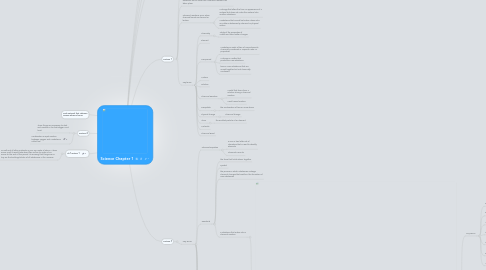
1. Fuel-material that releases energy when is burns
2. Section 4
2.1. Three things are necessary to start and maintain a fire fuel,oxygen, and heat.
2.2. Combustion-a rapid reaction between oxygen and a substance called fuel
3. Ch1 section 1
3.1. Ice salt and all other materials in your are made of atoms. Atoms are so small it would take about two million to make a line across to the end of this period. Its amazing that things are so tiny are the buildings blocks of all substances in the universe.
3.1.1. An atom cosisits of a nucleaus surrounded by one or more electrons. The nuclearus is the tiny central core of an atom. It contain particles called protons and neutrons. Protons have positive charge and nuetrons have no charge they are nuetral.
4. Subscript
4.1. a number in a chemical formula that tells the number of atoms in a molecule or the ratio of elements in acompound
4.1.1. Products
4.1.1.1. a substance formed as a result of a chemical reaction
5. a combination of symbols that represent the elements in a compound
6. a short, easy way to show a chemical reaction, using symbols instead of words
7. Matter may be in the form of elements, compounds, or mixtures
8. Section 1
8.1. Chemical changes result in the formation of new substances. Physical changes do not
8.2. Color change, production of a gas or a precipitate. a change in temperature, or a change in the properties of a substance are all clues that a chemical reaction has taken place
8.3. Chemical reactions occur when chemical bonds are formed or broken
8.3.1. a change that alters the form or appearance of a material but does not make the material into another substance
8.3.2. a substance that cannot be broken down intro any other substances by chemical or physical means
8.4. Key terms
8.4.1. Chemistry
8.4.1.1. Study of the properties of matter and how matter changes
8.4.2. Element
8.4.3. Compound
8.4.3.1. a substance made of two of more elements chemically combined in a specific ratio, or proportion
8.4.3.2. a change in matter that produces a new substance
8.4.3.3. two or more substances that are mixed together but not chemically combined
8.4.4. Mixture
8.4.5. Solution
8.4.6. Chemical Reaction
8.4.6.1. a solid that forms from a solution during a chemical reaction
8.4.6.2. a well-mixed mixture
8.4.7. Precipitate
8.4.7.1. the combination of two or more atoms
8.4.8. Physical change
8.4.8.1. Chemical change
8.4.9. Atom
8.4.9.1. the smallest particle of an element
8.4.10. Molecule
8.4.11. Chemical Bond
9. Section 2
9.1. Key Terms
9.1.1. Chemical Equation
9.1.1.1. a one or two letter set of characters that is used to identify elements
9.1.1.2. Chemical Formula
9.1.2. Reactants
9.1.2.1. the force that holds atoms together
9.1.2.2. Symbol
9.1.2.3. the process in which substances undergo chemical changes that results in the formation of new substances
9.1.2.4. a substance that enters into a chemical reaction
9.1.2.4.1. Section 3
9.1.3. Conservation of Mass
9.1.3.1. the principle stating that matter is not created or destroyed during a chemical reaction
9.1.4. Coefficient
9.1.4.1. a umber in front of a chemical formula in an equation that indicates how many molecules or atoms of each reactant and product are involved in a reaction
9.1.5. Synthesis
9.1.5.1. a chemical reaction in which two or more simple substances combine to form a new , more complex substance
9.1.6. Decomposition
9.1.6.1. a chemical reaction that breaks down compounds into simpler products
9.1.7. Replacement Reaction
9.1.7.1. a reaction in which one element replaces another in a compound; or when two elements in different compounds trade places
